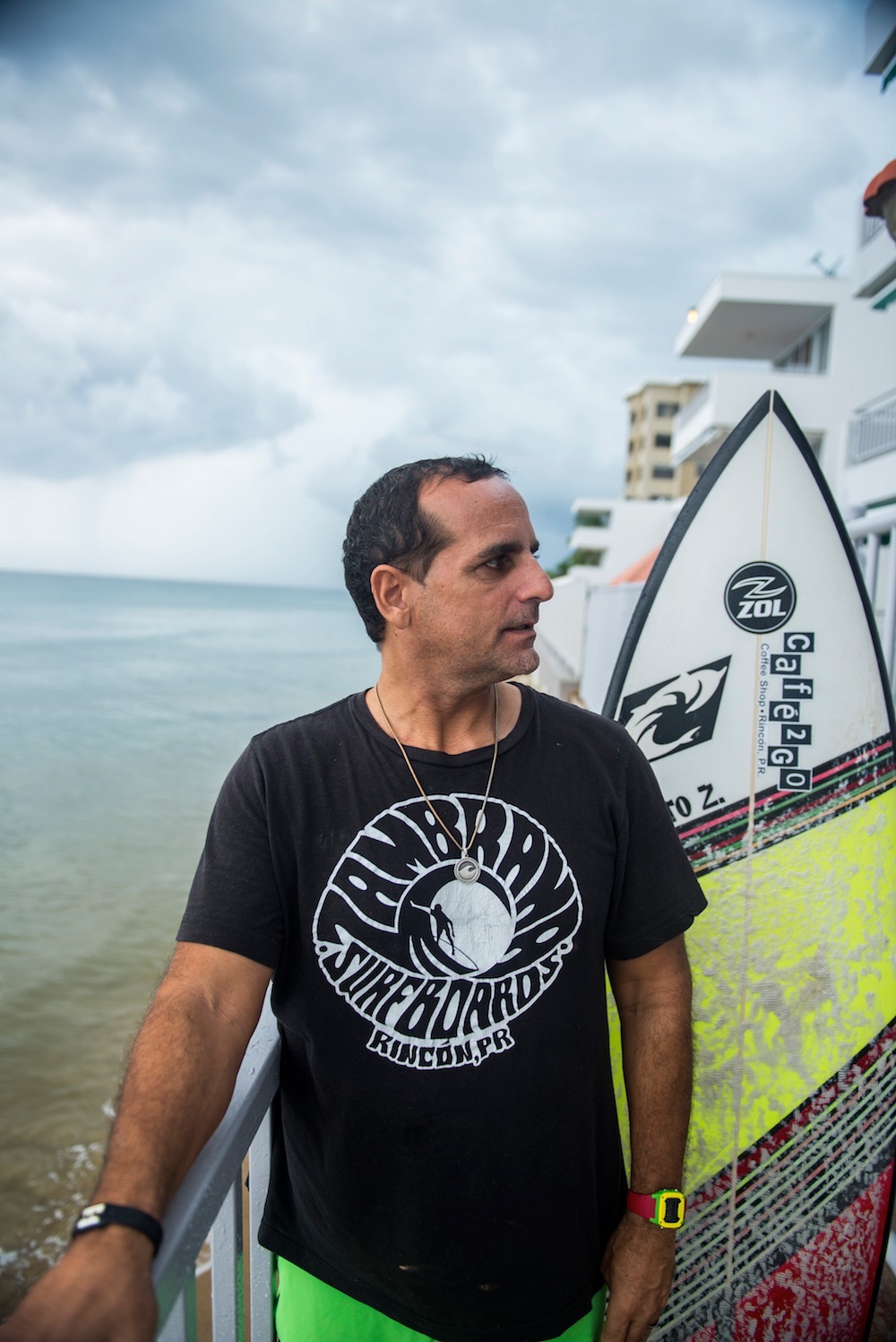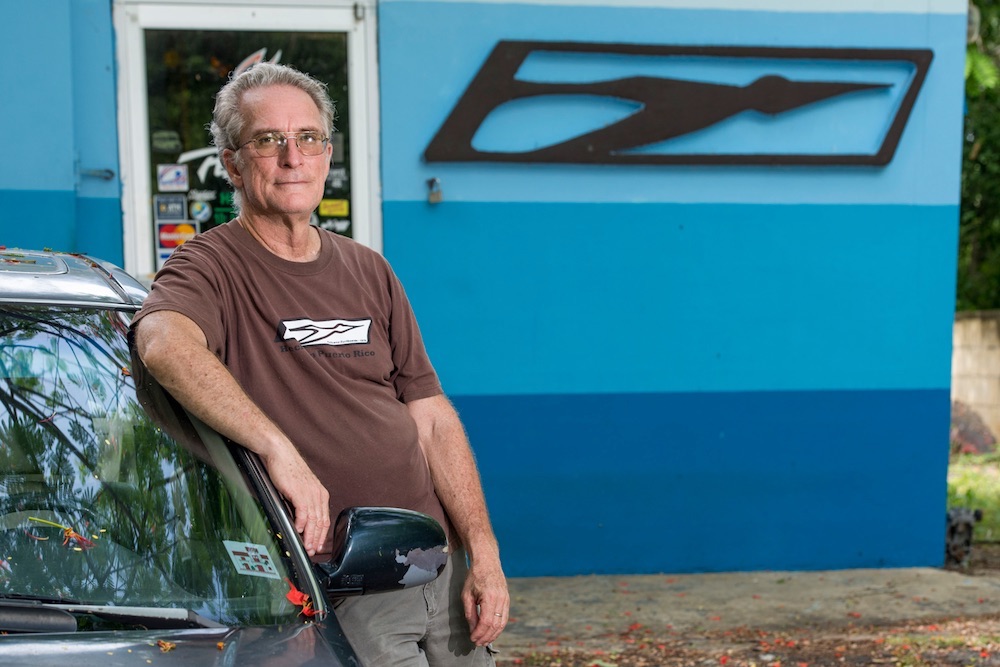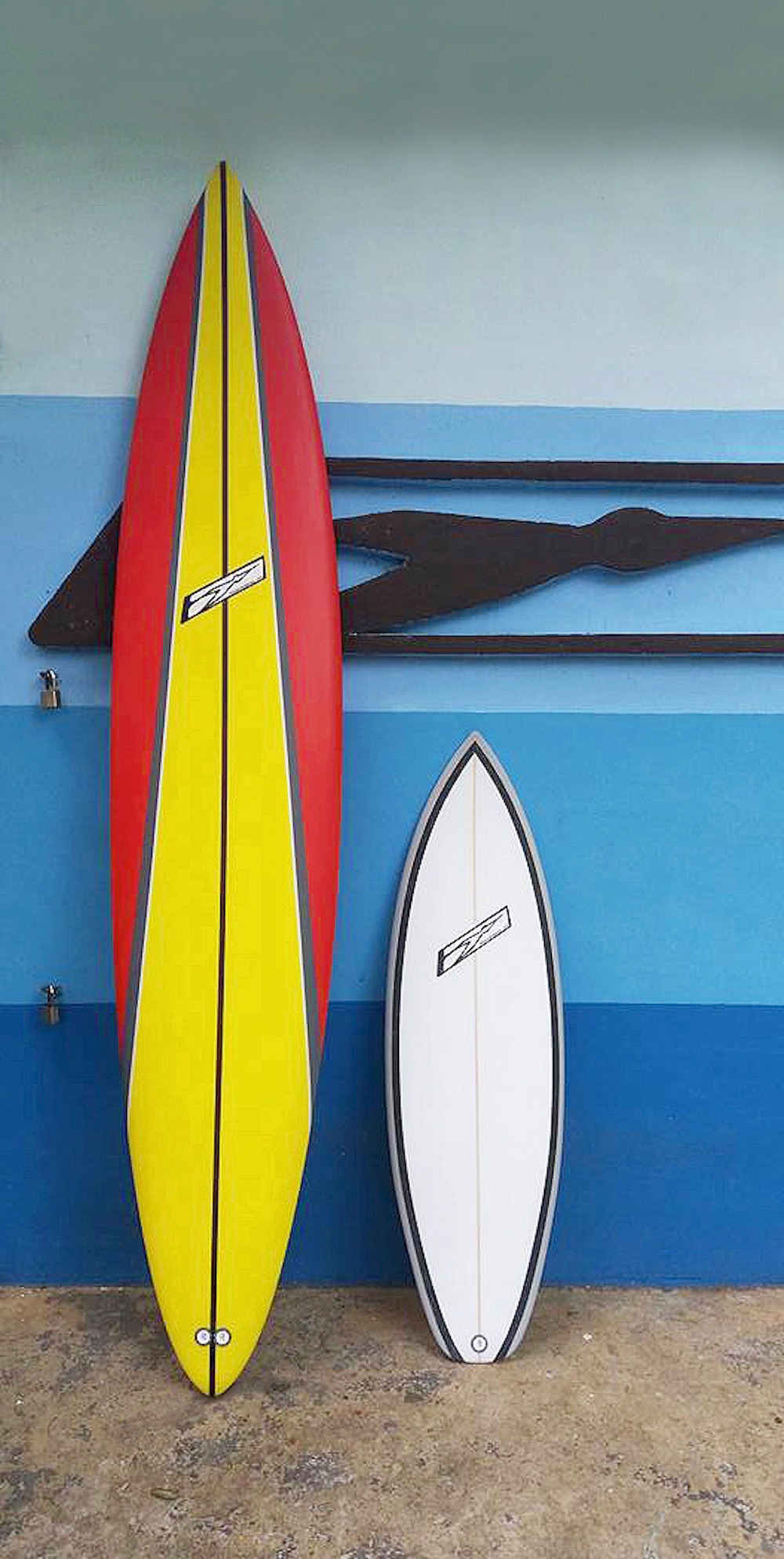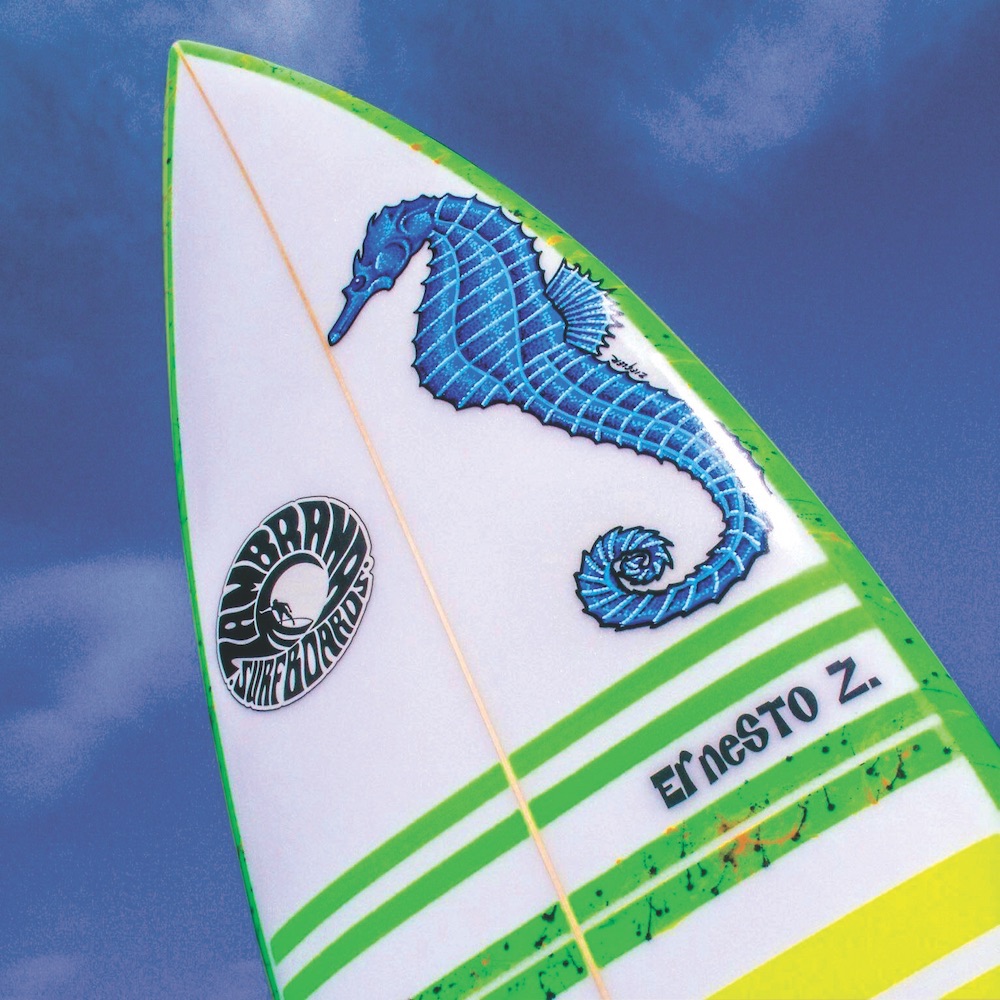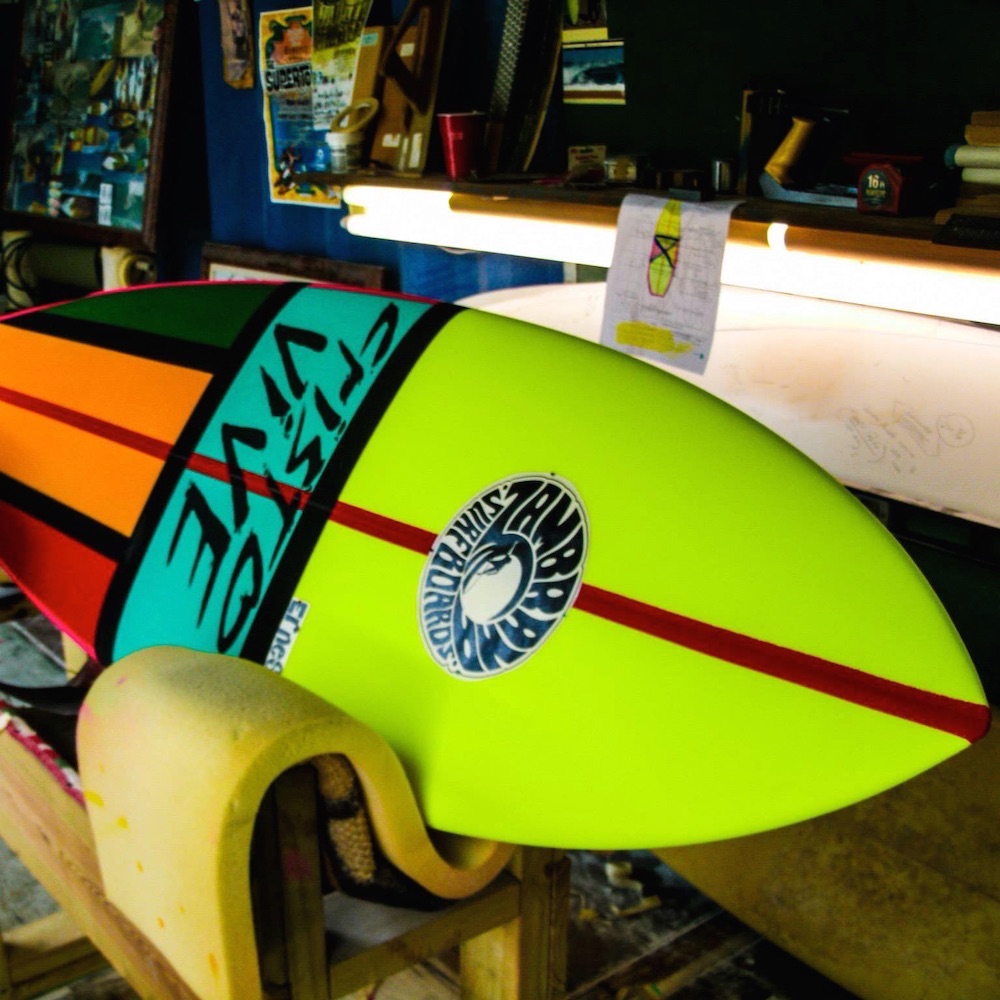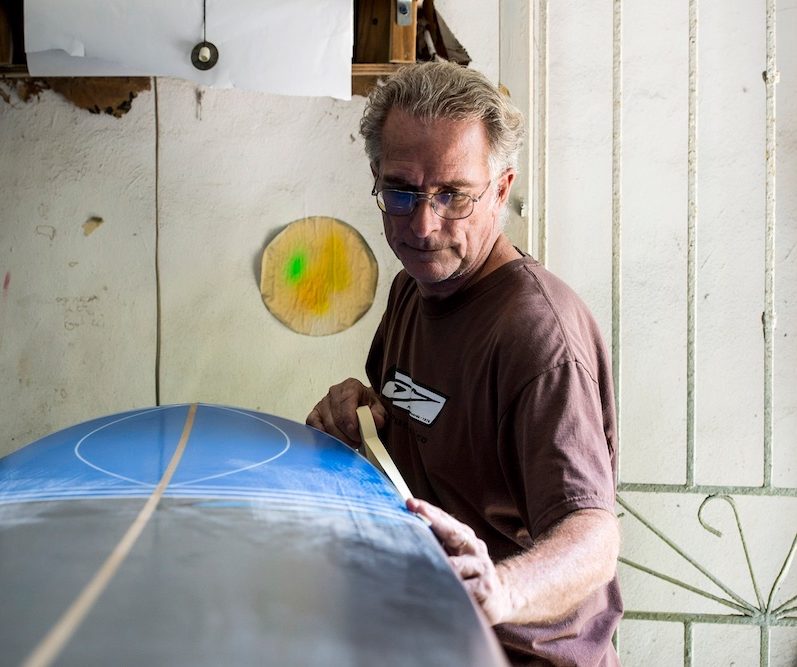Puerto Rican master board makers Nestor Ramirez of Pelicano Surfboards and Ernesto Zambrana of Zambrana Surfboards who reside in the northwest coast of Puerto Rico dubbed as the Hawaii of the Caribbean defy the international surf industry’s competitive marketing power and survive out of the sheer merit of their brilliant craftsmanship.
Finding Pelicano Surfboards factory is like searching for a secret safe house on the island. Visitors must drive along Barrio Bajura in Isabela, on a small road by the beach. Now and then the coastal brush from the side of the road clears up and gives a glimpse of peculiar rocky pond formations amidst white sand and deep blue water that are typical of this region’s shoreline.
Once on Road 4466, you locate the kilometer 1.6 sign, and enter an open gate on the right side, and keep driving until you come across a blue concrete rancher, not visible from the road with the image of a pelican, the logo of Pelicano Surfboards which is the life work of Ramirez, a senior master of Puerto Rico’s surfboard craftsmen, or shapers, as they are known in the surfing world.
Tall and fit for his age as most surfers, and grey haired in blue jeans and a t-shirt, the 61-year-old Ramirez, greets BIENVENIDOS warmly with a shy and friendly smile yet a let’s-get-to-business attitude.
Soon into the conversation it becomes apparent that Ramirez is a shy, soft spoken, and genuine individual with a no nonsense attitude, who is incapable of bragging or even mentioning his stature as a master shaper in Puerto Rico even with his 41 years of delivering top quality boards.
The love of waves and boards for Ramirez began in 1968 when at the age of 12 he surfed on a longboard shared with a friend on weekends in Pine Grove Beach, a popular spot for beginners in Isla Verde. After some months, Ramirez was given his first surfboard and there was no looking back. “My first board was a seven footer Mini-Corky Carroll model, named after a Hobbie team rider that was quite famous then,” he recalled.
Ramirez started shaping boards in 1974 at the age of 19 in his family’s home garage in Hato Rey, where he set up a workshop with his buddy Carlos Ramos and began his quest for excellence by trial and error.
He crafted his first products as “Taino Boards” but by 1976 Ramirez started the Pelicano Surfboards brand, probably the most prestigious and well known in the local scene.
Ramirez began fixing his own board which sparked his curiosity about the whole process of design and manufacture, especially when a book that explained the basics of board building fell into his hands.
“It was in English and I wasn’t too good at it but I figured out how to build them looking at the illustrations and the rest was trial and error,” said Ramirez. “There were no YouTube tutorials back then. Guys at the beach liked my boards and when I told them I built them, they started asking me to make surfboards and that’s how it all started.”
Three years later, Ramirez and his family packed their bags and moved to Aguadilla, a town in the northwest region of the island right in the middle of Puerto Rico’s prime surfing region that begins with Isabela on the north side and ends with Rincon on the west.
There he perfected his board making skills for 19 years. “Coming to live here was one of my dreams,” sighed Ramirez.
Inside the workshop, tricks of the trade
The process starts with the shaping of the boards that are made of foam, mostly polyurethane or expanded polystyrene, which is a lighter foam material. Then a fiberglass sheet is fit to the board with resin over it.
“We have two ways of applying color to the boards, one is mixing color pigments in with the resin, what we call resin tints, and the other is airbrushing directly on the foam board,” explains Ramirez. “We do both here and my son Guaili works the resin and the tints while I do the shaping of the boards and the airbrushing. Also sometimes we work with foam tint where we put the colored resin directly on the foam board and then put the fiber glass on top. There are a lot of small tricks in this.”
The shaping room looks like a battlefield surgery unit where the board is the patient and Ramirez is the surgeon. The prime tool used for shaping is a plainer, an electrical brush originally designed to work on wooden doors. Armed with his tool and various types of sandpaper, the master works the board until he achieves the desired dimensions that will fit the client’s need; be it a faster board, a more agile one to swirl up and down the waves, a board for big waves or one that would be better for expert riders or for beginners. Special side lights on the room walls are designed to reveal imperfections on the board’s surface that would need further polishing to achieve an impeccably smooth finish.
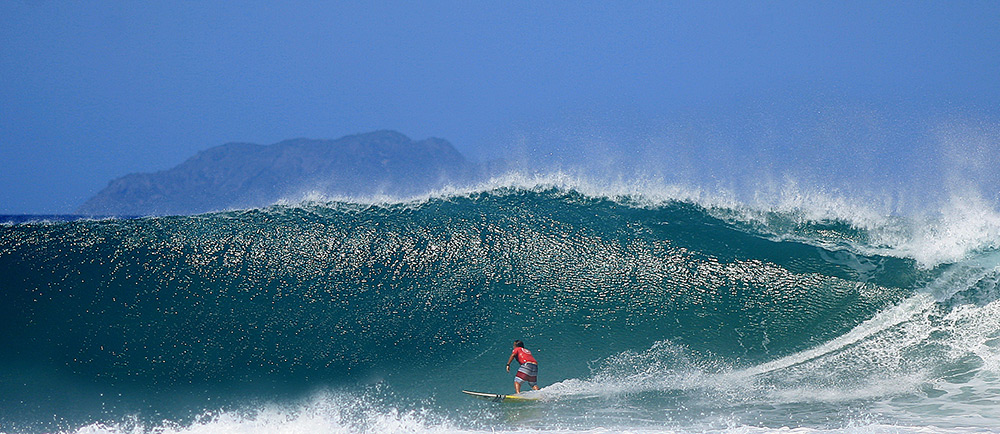
From dominant trends to ‘anything goes’
Board designs have varied with the times. In the sixties there were the longboards (over 9 feet long) after 1967 and in the 70’s, the boards were in the 7 feet and under range and became even smaller. In the 1990’s most of the boards were 6 to 6.4 feet long, thin, narrow, and white with fluorescent airbrushed colors.
“Man it was boring to make surfboards during the 90’s because people were always asking for the same type of boards. Almost all of my work is custom-made and surfers then wouldn’t want anything else, so I was making more money, but it was boring,” Ramirez said.
Things started changing
“Surfers were using longboards and fun boards, which are a kind of a narrower and smaller longboard; fish boards, that have the swallowtail, and smaller boards that are becoming quite popular again in the last five years, but still anything goes, there is variety and it’s much more fun to shape boards these days,” Ramirez added.
With the longboard, according to Ramirez, it’s easier to ride the wave, especially for beginners, but it also has its style for experienced surfers, like walking the board.
The big boards, known as guns; are narrow, 8 to 9 feet long and are used to ride big waves ranging from 10 to more than 30 feet high.
Ramirez’ boards, signed Nestor Shapes, range from $425 to $800 and the production process takes around 4 to 6 weeks to complete. He makes boards for all types of surfers from the beginner to the pro. Although most of his clients are local he does have faithful followers in the Dominican Republic and the east coast of the U.S. mainland.
“People who really know about surfing know our boards are as good or better than any of the popular California trademarks such as the Channel Islands and Dan Love, but what people tend to see are world famous surfers photographed in magazines riding the big brand boards which sponsor them and this type of marketing works,” Ramirez said.
As a result, the surf shops in Puerto Rico import most of their boards from California and don’t buy local brands. Ramirez sells some of his boards at the Parada Ocho Surfshop in San Juan, but like most of the local producers, he mostly makes custom-made boards for individual clients.
And what makes this expert craftsman continue his board making passion after 41 years, the answer is simple: he just loves what he does.
“My greatest satisfaction is when a client tells me, hey man the board you made for me is awesome, or when somebody says the board is magical, which in surfing jargon means a board almost rides by itself, does whatever you want it to do; well, that’s what drives me to continue,” Ramirez concluded.
Ernesto Zambrana: Surfboard design is art
Zambrana is another of Puerto Rico’s prime board shapers. At 53 years of age he’s half a generation younger than Ramirez, and is also a city boy surfer who ended up settling roots in the surfing strip of the northwest coast, in his case, in the western town of Rincon, where he builds Zambrana Surfboards.
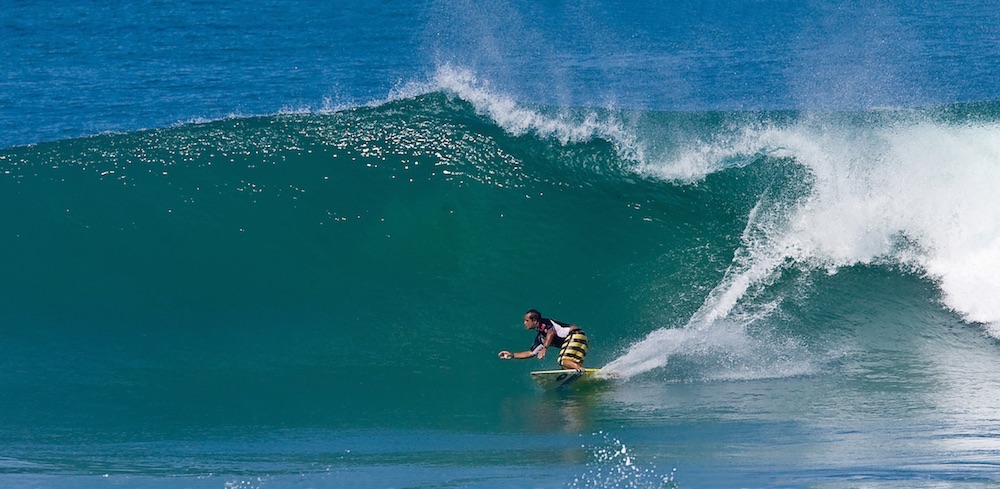
Zambrana’s love affair with surfing started early
As a toddler Zambrana spent weekends in a beach apartment in Condado, right near La Punta, one of the surfing spots in the San Juan metro area. For hours he would sit on the sand and watch the surfers ride the waves, imagining it was him on top of those magical boards.
“When I was 9 I was invited to a Cub Scout picnic on the beach and somebody lent me a board. I just went for it and on my first try I stood up and rode the wave, as natural as a kid learning to run, and that was it. No turning back,” said Zambrana, who appears younger than his age.
In the late 1970’s when Zambrana was 12, he and his younger brother got surfboards for Christmas. His was a 7.2 foot Hawaiian style, single fin pintail model from Wave Riding Vehicles (WRV). “Not in my wildest dreams could I have ever imagined then that many years later WRV, a world renowned brand, would ask me to design boards for them!” exclaimed Zambrana while opening his eyes widely.
After a year of surfing at the San Juan “school beaches” in Pine Grove and the Sheraton Beach in Condado (right in front of the San Juan Marriott Resort), Zambrana and his friends began paddling into more challenging waters at Aviones Beach in Loiza.
“By 1976 I was a good surfer and we were making our pilgrimages to Rincon, considered not only the prime surfing area in Puerto Rico, but one of the best venues worldwide. At Aviones you could find some of the best surfers, I even got to surf with world champion Kelly Slater, who was a young rising star at the time,” Zambrana said. “He used to call me Conan the Barbarian because he was a skinny teenager and I’ve always had a wide sturdy frame, so Kelly joked that I might just beat him up if he got in front of me and ruined my ride.”
Surfboards were getting expensive in the 80’s and Zambrana couldn’t afford the one’s he liked, so he became interested in making his own.
Puerto Rico’s established shapers were not willing to share the tricks of the trade but Zambrana, who was studying sculpture at San Juan’s School of Plastic Arts, teamed up with a friend who had some experience. They set up a clandestine shaping room in a storage area inside the historical Maunabo Lighthouse, situated in the east coast of the island, where his partner and first mentor worked as a lighthouse keeper.
“We were kicked out of there a year later of course, but that’s where I learned the trade,” Zambrana laughed.
Zambrana and some other emerging shapers got prime materials from Bill Balke, an American hippie who drifted to Puerto Rico’s northwest coast in the 60’s. Balke had settled in Aguada, a town next to Rincon, however, besides being a free spirit he was also a chemical engineer, who was very savvy about the use of resins and tints.
“Bill was a very important guy in the development of shapers in Puerto Rico because he gave us advice and even had shaping rooms in his place where guys could build their boards,” Zambrana recalled.
“Rincon to surfers is the Hawaii of the Caribbean and the east coast of the U.S.,” Zambrana said. “Swells at Tres Palmas and Maria’s beaches, get up to 40 feet, the biggest waves ever documented in the Caribbean and the U.S. east coast. It’s not unusual to find celebrity surfers around here. Garret McNamara, who is sponsored by Mercedes Benz and is a big wave surfer of the world, was in Tres Palmas a couple of years ago,” Zambrana said.
Zambrana, who is a skilled surfer himself, showed BIENVENIDOS one of the boards he designed and built for the WRV brand, which he signs as Ernesto Z.
“Shaping is the extension of my passion for surfing,” said Zambrana with a sparkle in his eyes. “It enables me to fuse my two greatest passions, surfing and art. Creating boards is a mix of engineering with art. When I make custom boards I work with the surfer’s experience, size, and weight; one has to take all those elements into account to design the measurements.”
Lately Zambrana has been concentrating on just board design and airbrush artwork.
“Besides the functional quality, the board is like a white canvas and you create art out of it. So I use prints, photos, or drawings in rice paper and combine it with airbrush technique, freehand painting using stencils, which adds esthetics to the board. For health reasons, I do not work with lamination, resins, and fumes, so I contract that part of the work to Guaili, Nestor Ramirez’s son, who has become quite an expert,” Zambrana said.
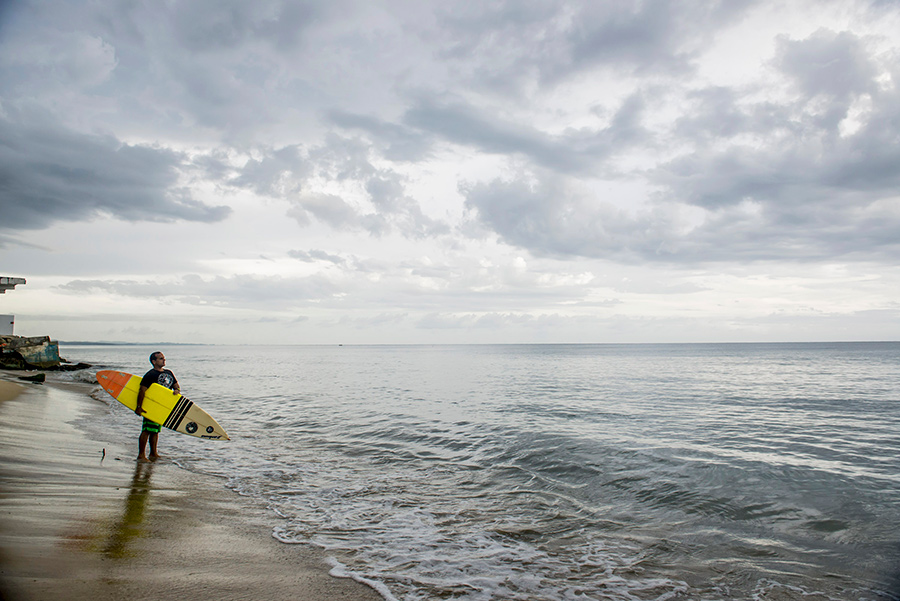
A living legend riding your board
Zambrana likes building boards for small kids and enjoys the fact that he has made the first surfboards for many top local surfers like Jorge and Christian Rivera.
“But one of my greatest satisfaction was building a board for Tom Curren, a three-time World Champion and one of the greatest surfers of all times,” Zambrana said. “I gave the board to Tom as a gift when he came for the premier of a documentary about the Billabong riding team that was filmed in Rincon in 2000. I didn’t make much of it because I thought he wouldn’t even ride it.”
But then a friend called Zambrana one morning and informed him he saw Curren riding the board he made for him in a two-page spread inside an Australian surf magazine. “I just told my friend that it was too early for pranks. But it was true,” Zambrana recalled, reliving his astonishment.
Curren was photographed in Surfer Magazine and other international publications riding Zambrana’s board, even though he had the best brands in the world available to him. “In some of the photos you can even see a small Puerto Rican flag that I painted on the side so he could remember where the board came from,” Zambrana said. “It was a three fin 6’10” foot pintail, not the kind Tom usually rode, so it seemed like he wanted to try something different.”
In 2010, the World Surfing Championship was held at Middles Beach in Isabela, where Kelly Slater won his 10th championship
“I got to meet and become friends with Tom at this event. I introduced myself and asked him about the board, and he told me he liked it and had traveled around with it. It was a great experience to me,” said Zambrana with pride.
Technology allows concentration on design
Zambrana, who still makes boards for WRV (as also Nestor Ramirez does) and constructs his own Zambrana Surfboards brand with prices ranging from $475 to $650; mostly sells his product directly to customers.
“The advantage of being a surfer and a board maker is that you can test your own product which enables you to know what works and what doesn’t,” Zambrana said.
For the past four years, Zambrana has been working with a computer numerical control (CNC) machine that uses computer technology to shape boards. There is only one CNC machine in Puerto Rico and it’s used mainly to build paddle boards.
Zambrana says he is the only shaper who uses it regularly in Puerto Rico. “It gives me a chance to concentrate in design. I have several models and in 30 minutes I have them. Guaili does the resin application for me and I only have to work the details and art. The best thing is that I am able to clone my models,” Zambrana said.
Teaching the trade
After a lifetime of visiting Rincon, first vacationing there as a kid and then visiting to surf, Zambrana moved to Barrio Corcega six years ago with his wife Laura and their teenage kids.
“This is Puerto Rico’s surfing capital, but there is more to it. It’s Puerto Rico’s only town without traffic lights, where you won’t see a drug addict on a street corner, and where so many people work to protect the environment,” Zambrana said. “My way of sharing is to teach kids how to make and fix their boards. One of my goals is to set up a school where I can teach board shaping and surfing.”
Not only are kids learning the trade with Zambrana, Ricky Muñiz, one of the top new shapers who travels to expo-shows in U.S. mainland with his boards learned from him and he also provided shaping sessions to Rob Machado, yet another Californian former world surfing champion, who was venturing into shaping.
“Surfing is not a hobby; it’s a way of life. Maybe being in contact with nature and the sea all the time makes us different,” Zambrana said. “So I decided to be a board maker instead of a full-time sculptor. Although from now and then I work on sculptures, my love for surfing was just too much. I guess my destiny was to become a sculptor and painter of surfboards.”


